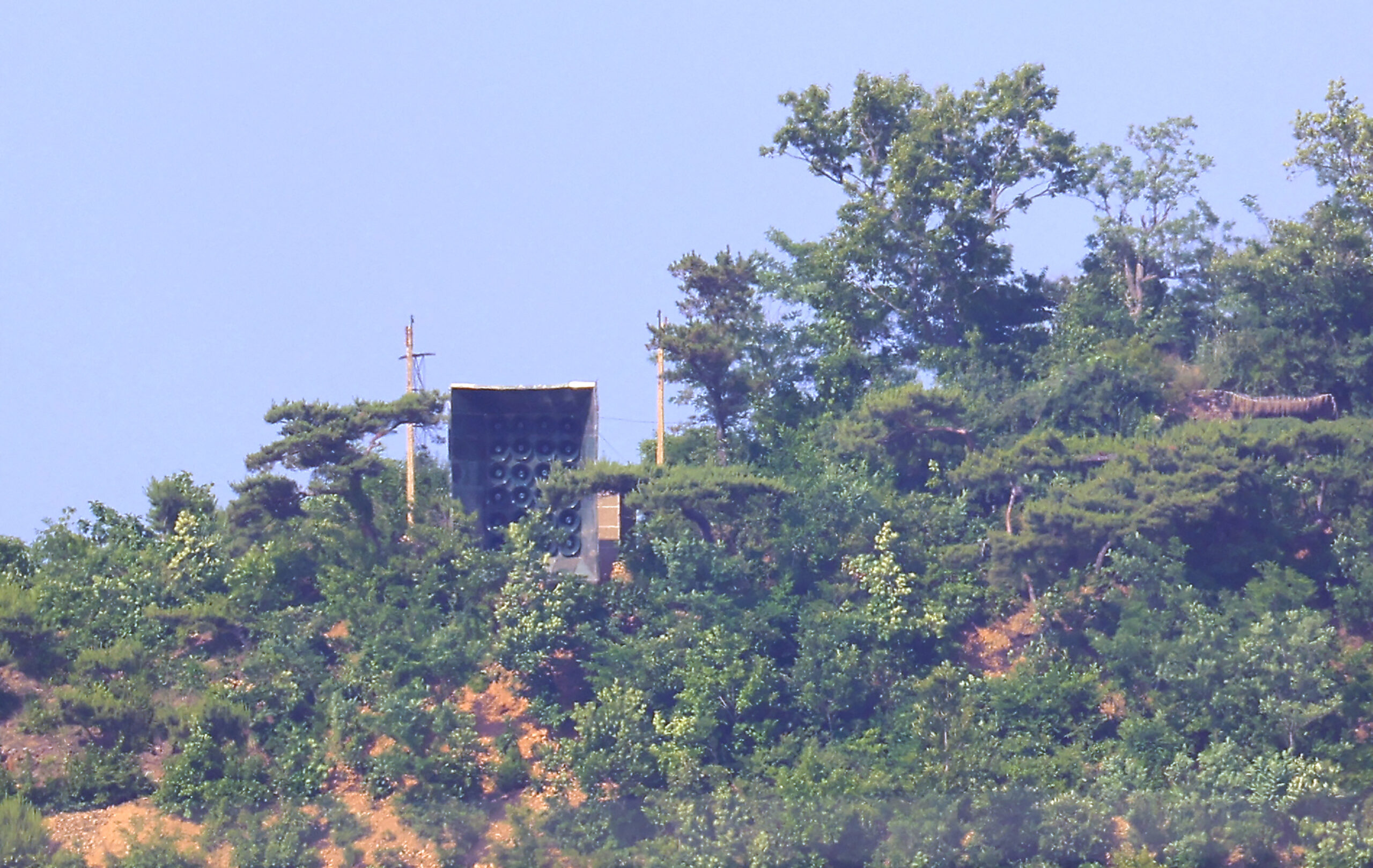
A facility (C) believed to be North Korean loudspeakers are seen at the top of a hill in North Korea as viewed from South Korea’s Ganghwa Island near the Demilitarized Zone (DMZ) dividing the two Koreas on June 11, 2024. South Korean troops fired warning shots after North Korean soldiers briefly crossed the border this week, Seoul’s military said on June 11, with tensions high over Pyongyang’s barrage of trash-carrying balloons and the South’s retaliatory loudspeaker campaign. YONHAP/Agence France-Presse
SEOUL — Seoul’s military said Friday it had fired warning shots after North Korean soldiers briefly crossed the heavily fortified border in the third such incursion this month.
The nuclear-armed North has been reinforcing the border in recent months, adding tactical roads and laying more landmines, which has led to “casualties” among its troops due to accidental explosions, South Korea has said.
On Thursday morning, “several North Korean soldiers who were working inside the DMZ on the central front line crossed the Military Demarcation Line,” Seoul’s Joint Chiefs of Staff said.
READ: South Korea fires warning shots after North Korea soldiers cross border
“After our military’s warning broadcasts and warning shots, the North Korean soldiers retreated back northward,” they added.
Similar incidents took place on June 9 and Tuesday this week, with Seoul’s military saying both incursions appeared to be accidental.
Relations between the two Koreas are at one of their lowest points in years, with Kim Jong Un hosting Russian leader Vladmir Putin this week, and signing a mutual defense agreement that has raised hackles in Seoul.
In response, the South — a major weapons exporter — has said it will “reconsider” a longstanding policy that has prevented it from supplying arms directly to Ukraine.
READ: Seoul fires warning shots as N. Korean soldiers cross border again
“While attention is focused on Putin’s pariah partnerships, the Kim regime is recklessly endangering soldiers with rushed construction work at the inter-Korean border,” said Leif-Eric Easley, a professor at Ewha University in Seoul.
The work is likely aimed “as much at keeping their countrymen in as it is at keeping the South Koreans out,” he said, but warned that “a lack of inter-Korean communication channels and confidence-building mechanisms increases the danger of escalation in border areas.”
Balloon war
The two Koreas have also been locked in a tit-for-tat “balloon war”, with an activist in the South confirming Friday that he had floated more balloons carrying propaganda north, a move likely to trigger a response from Pyongyang, which has already sent more than a thousand balloons carrying trash southward.
Legally, Seoul cannot prevent activists from sending balloons across the border, after a 2023 court ruling that it was an unjustifiable infringement on free speech.
Activist Park Sang-hak, a former North Korean who defected and has been sending anti-regime leaflets north for years, said he had floated 20 balloons across the border Thursday, carrying propaganda as well as flash drives of K-pop music and K-drama.
The North is extremely sensitive about its people accessing South Korean pop culture, with a United Nations report saying possession of large amounts of such content has been known to result in the death penalty.
Activist Park said there was a “bit of friction” with city officials in Paju — the area where the balloons were launched — but he vowed not to call off his campaign unless Kim Jong Un “apologizes” for sending trash.
North Korea has slammed the propaganda balloons as “intemperate psychological warfare of the scum who defected” and warned it will respond to every launch in kind.
Tensions over the dueling propaganda have previously boiled over in dramatic fashion.
In 2020, blaming the anti-North leaflets, Pyongyang unilaterally cut off all official military and political communication links with Seoul and blew up a disused inter-Korean liaison office on its side of the border.